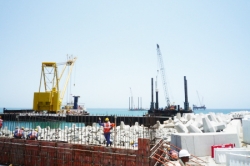Business & Finance Club - MUSCAT — The Port of Sohar is developing two large-scale projects which promise to transform the wider Batinah region into a regional powerhouse for industrial-scale mining, quarrying and mineral processing activities.
The first project is the development of a major deepwater bulk jetty to support the bulk shipping needs of Brazilian mining conglomerate Vale, which is building a huge iron ore pelletising and distribution centre at the industrial port.
Construction work on the deepwater bulk jetty is well under way. A joint venture of Italy-based international engineering contractor Saipem and leading Indian infrastructure firm AFCONS, is undertaking the design and execution of the jetty structure.
The 1,380-metre-long structure, which extends straight into the Sea of Oman, is itself a major feat of maritime engineering. Around 500 piles will be placed on which the trestle and the jetty platforms will be constructed.
Berthing pockets with a draft of 25 metres will allow for the docking of a new generation of ultra-large ore carriers which are being owned and operated by Oman Shipping Company.
This jetty will take Sohar into the ranks of only a select handful of ports in the world with such deepwater capability. Van Oord of The Netherlands, one of the world’s leading dredging companies, has made significant headway in dredging the approach channel and berthing pockets, having so far dredged some 8 million cubic metres from the seabed. The company has deployed one of the world’s largest dredgers at site.
Port officials along with the contracting consortium are working towards a very ambitious schedule to bring part of the jetty into operation by the first quarter of 2011 to coincide with the scheduled commencement of Vale’s pelletising activities.
The jetty will be fully operational in the second part of 2011. The overall investment in the dredging, construction of the jetty, and the supporting infrastructure will be $250 million.
The second project is the development of a General Dry Bulk and Aggregates Terminal. “The investment in the Dry Bulk Terminal will add to the versatility of the Port of Sohar,” commented Jan Meijer, the CEO of Sohar Industrial Port Company SAOC (SIPC). “With this facility, we will have the capacity to handle bulk imports and exports of aggregates, as well as commodities like limestone, coal, cement, and chromite, to name a few. As a big industrial port, our capability will not be limited to the handling of containers, general cargo, liquids, and petrochemicals, but will also extend to all kinds of bulk commodities.”
A 200-metre-long section along the jetty-trestle will be developed into a dedicated platform for the import and export of aggregates and bulk commodities. The platform is located close to where the giant ore carriers from Brazil will discharge their iron ore for Vale’s pelletising plant. Conveyor belts running along the length of the jetty will connect the platform to a special stockyard for both imports and exports. Loading and unloading of ships will be done by mechanical arms hooked to the conveyor system.
The new platform, involving an investment of several tens of millions of dollars, will have a capacity to handle 6-10 million tonnes of aggregates and dry bulk commodities per year. Investments in the superstructure, such as the loading/unloading arms and other facilities, will be made by a platform operator, whose selection is currently being finalised, according to port officials.
Importantly, the platform is expected to encourage the growth of the aggregates industry in the hinterland of the port. Large volumes of aggregates are currently shipped to Qatar and Bahrain, among other markets, where a construction boom is underway. With the construction of a dedicated dry bulk jetty, authorities envision a growth in quarrying and mining activities along the Batinah region. Investors will enter the market to supply resource-poor Gulf and Middle East markets using Sohar as a gateway.
The new Aggregates and Dry Bulk Platform is targeted for completion by the first quarter of 2012. Until that time, a temporarily facility could become available to start the operations already in 2010.
In addition to the potentially promising investment opportunities arising out of the construction of the new aggregates and dry bulk platform, port officials envisage huge implications for employment generation. Significant numbers of jobs will be created across the business chain, extending from quarrying and mining to processing and value addition, and transport and logistics. This is in addition to the thousands of jobs created during the implementation phase of both jetty projects.


